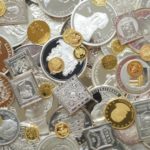Another Bretton Woods Gathering To Solve A Global Problem
(April 26, 2019 - Jeffrey Snider)
In the Spring of 1944, the world’s attention was rightly focused elsewhere. American and British troops were stuck at the Anzio beachhead in Italy, surrounded by Germans. The Red Army was flooding into the Ukraine. While the US Navy and Marines were island hopping Japanese strongholds throughout the Pacific, the Empire of Japan launched Operation Icho-Go in central China in the vain attempt to halt American bombers launching strikes from the region on its home islands.
And there was that massive buildup in England toward what everyone knew was the coming invasion of Europe.
While the youth of so many nations slugged it out in faraway places amidst devastating carnage and often total destruction, officials gathered in the US to begin planning for a new postwar order. There were political discussions about a great number of topics, how a defeated Germany and Japan might be dealt with, but also the more mundane mechanical necessities.
The Treasury Department had organized, convened, and otherwise supported working groups of financial professionals in cities across the country. Boston, Chicago, Philadelphia, St. Louis, New York. In each place, experts had gathered in the early months of ’44 to figure out the best way to solve one factor which may have been the greatest contributor to World War II.
If the Great Depression had fanned the flames of internal resentments into global disharmony, the best course would be to avoid another one. Hardly anyone, though, could agree on a common cause. Where everyone did find common ground was in how once begun it had spread all over.
On April 21, 1944, seventy-five years ago this week, a joint statement was issued. The Experts on the Establishment of an International Monetary Fund of the United and Associated Nations was a working group of delegates drawn from dozens of those nations. Primarily the work of the US, UK, and Canada, less than two months before D-day this declaration was the first step toward the international arrangement everyone hoped would follow from the invasion’s ultimate success.
“As a result of discussions among the technical experts of more than 30 of the United and Associated Nations, the conclusion was reached that the most practical method of assuring international monetary cooperation is through the establishment of an International Monetary Fund.”
The IMF was not meant to be what it has become today. Indeed, the April ’44 communication was actually the first step toward what would be known to history as Bretton Woods. The system of gold-exchange which would light the way for a war-ravaged world to move into unparalleled prosperity was born from it. That the IMF was at the center was no accident.
When the full conference at Bretton Woods, New Hampshire, was held in early July 1944, the first of its three commissions was dedicated to the IMF. Chaired by the chief American negotiator, Harry Dexter White, Assistant to US Treasury Secretary Henry Morgenthau, who presided over the whole conference, the task was to create a mechanism for fair settlement of global imbalances.
The very first sentences in the introductory statement went straight to the point:
“When currency systems were restored after the last war, there was little or no attempt at coordination of measures to provide stability; no machinery was set up to facilitate an orderly adjustment of exchange rates when fundamental conditions necessitated such a revision. The disturbances of the 1930’s, involving a resort to competitive currency depreciation, imposition of exchange restrictions, import quotas, and other devices which all but stifled trade, made it clear that improved international financial arrangements were necessary.”
It was equally clear, given the very raw history of the thirties then the forties, why this was so important. The April 1944 Joint Statement set out these overriding concerns. The principles that would guide the IMF eventually gold-exchange Bretton Woods were first and foremost:
“1. To promote international monetary cooperation through a permanent institution which provides the machinery for consultation on international monetary problems.
“2. To facilitate the expansion and balanced growth of international trade and to contribute in this way to the maintenance of a high level of employment and real income, which must be a primary objective of economic policy.”
We give almost no consideration to what a reserve currency is today. It is almost always thought of in terms of something like oil, the US dollar means people in the United States get to price the vital commodity in their own currency. Some like to talk about a petrodollar as if that actually means something.
There are very crucial roles that any reserve currency must fill. These were best described in detail by Robert Solomon, the Federal Reserve’s chief international monetary expert, who decades later as Bretton Woods unraveled counseled the IMF toward recognizing what was wrong.
A reserve currency, Solomon said, must provide three functions: liquidity, adjustment, and confidence. Under Bretton Woods, it was gold which was meant for the last, and US dollars along with British pound sterling currency for the first. No one gave much thought to the middle because in 1944 a more fully globalized world was still too far distant.
A reserve currency is an intermediator, more than a buffer between national systems often with very little in common. Starting with currency denomination and monetary terms. The example I often use is an export firm in Sweden obtaining goods in that country to be shipped to Japan for final use. The trade can certainly happen without a global reserve, but not efficiently.
The Japanese importer somehow has to find kronor and then send it to Sweden for payment. Otherwise, the Swedish exporter has to accept yen and then find something to do with it while the funds are now trapped far away from their home. These are not likely to be successful scenarios.
The firms can appeal to help from each’s local banking networks, though here, too, there are serious drawbacks. The Japanese bank must find and maintain a stockpile of kronor made available to Japanese importers. Alternately, Swedish banks must be capable of regularly and efficiently disposing of yen. These are not likely successful scenarios, either.
If, however, both sides can use a currency that is common in both areas it then obviates the need for either of their national denominations. Should Japanese as well as Swedish banks both hold balances of this middle currency as a regular part of their business, no special concessions required, then trade becomes easy and (very nearly) free.
The downside is that this requires a whole lot of that middle currency to be made available practically everywhere. Under Bretton Woods, the task of the IMF was originally to foster that sort of liquidity – meaning redistribution of monetary resources when imbalances arose.
In more practical terms, it just wasn’t realistic. As Economist Robert Triffin famously described, the Bretton Woods system was set up at odds with its own mechanisms. Gold remained convertible into dollars and sterling at a fixed price, therefore limiting quantities, while at the same time a globalizing world required more and more of a middle (reserve) currency to facilitate trade that began to really, truly flourish.
Gold-exchange effectively lasted just sixteen years until the establishment of the London gold pool in 1960. The IMF in the sixties was highly active by necessity yet helpless.
The world needed liquidity and adjustment not just its confidence. Liquidity, though, is no easy trick. It requires momentous resources, the voluntary heavy participation of a broad cross section of private financial institutions. There needs to be substantial infrastructure, a dependable marketplace whereby the firm or bank in Sweden or Japan knows that it can efficiently source the middle currency. And never give it a moment’s thought.
How that middle currency is sourced changes with time. The adjustment function is perhaps the most misunderstood piece of a global reserve currency architecture. It’s like this with a lot of modern Economics, a discipline dedicated to describing a world which in its theories always stands still.
We live in a dynamic world. Change is the only constant. Innovation and evolution are factors in money and finance just as they are in technology and medicine. As the world around it is altered and altered again, so, too, must be the middle currency.
This adjustability applies to liquidity as well as confidence. Can the reserve currency be settled by anything other than actual bars of bullion, or even stacks of physical currency notes? In today’s digital world, trade settlement that might’ve been booked by something like a banker’s acceptance long ago and changed to certificates of deposit somewhere in the middle now have to incorporate swaps, forwards, and multi-faceted derivatives (footnote dollars, so to speak).
That’s adjustment, the flexibility in the design of the currency system to evolve with our dynamic, innovative world.
Small wonder, then, that a credit-based, offshore global reserve system rose up to replace gold-exchange. It performed all the roles (almost) beautifully, at the same time (nearly) living up to the ideals set forth by that very first joint statement of the experts. A globalizing global economy meant prosperity shared worldwide. Behind the scenes very necessary for it, a flexible monetary design which allowed for, even incentivized, imagination (adjustment) as well as immense support (liquidity).
And it was all denominated in US dollars (confidence). This eurodollar. It only went too far. Way, way too far.
Small wonder, too, that coincidentally beginning March 2009 serious complaints began to be lodged in public. First the Chinese who were immediately dismissed as geopolitical saber-rattlers. It is a huge mistake to assume such single motivation.
That was more than ten years ago, plenty of time for any organic problems which may have arisen, as our current set of officials claim (subprime), to have long since passed into history. They haven’t, if anything the complaints about the dollar grow louder and more persistent with each passing, recovery-less year.
It’s very easy to presume only politics because, again, hardly anyone (politicians included; actually, politicians are right at the top of this list of offenders) bothers to consider what a global reserve currency is and what it does; or is supposed to do. To everyone, there’s dollars and…
So, potential global dollar shortage makes no sense. To the people who pay no attention to these things, are aware of none of its history, this can’t be a problem.
Yet, just a few days ago the Wall Street Journal, of all mainstream Economics mouthpieces, meekly reported:
“China’s major commercial banks have a funding issue outside Beijing’s control: They’re running low on the U.S. dollars they need for activities both at home and abroad.”
At home and abroad, sort of like the functions of a middle currency?
This is not a new development, either, not that you would know it from the text of the article. The chart accompanying it does describe well enough a situation that is more than half a decade in arrears. It predates QT and “rate hikes” all the typical mainstream stuff which usually gets carelessly applied to anything so inconvenient.
I wrote five years ago, in March 2014:
“What all this data shows, as opposed to conjecture about the supernatural powers of central banks, is that yuan’s devaluation may be directly tied to dollar shortages. In fact, as I argue here, it is far more plausible that a dollar shortage (showing up as a rising dollar, or depreciating yuan) is forcing the PBOC to allow a wider band in order that Chinese banks can more ‘aggressively’ obtain dollars they desperately need. Worse than that, the PBOC itself cannot meet that need with its own ‘reserve’ actions without further upsetting the entire fragile system.”
I wrote that in response to a contemporary Journal article which purported CNY’s decline, at the time just getting started, was intentional (the whole supernatural powers thing was the Journal claiming the PBOC was actually engineering the currency’s drop to punish and drive out speculators!) In the half decade since, a little more than $900 billion have disappeared from China’s official reserve count. Up and vanished.
Where’d a trillion dollars in reserves go? More importantly, why?
These are questions no one answers. The latest article which admits to China’s dollar problem conspicuously asks neither. It is still too far outside of mainstream intellectual convention, this massive disconnect between what actually goes on in the real world and what we are told to believe goes on. Should the difference between these grow too large, well, that’s how you get something like 2008.
What connects 2008 to 2019, as you may have noticed lately, is liquidity, adjustment, and confidence. Or, more appropriate, the at times heavy absence of liquidity, like today, the very much still misunderstood nature of adjustment, as well as more and more the decline in confidence. The middle currency has persistently degraded in all three phases.
Thus, if you are an importer in Japan, perhaps China, and you go to your local bank looking for dollars to buy and import something on the global market and your local bank says, sorry, what next? You can, as before, attempt to find some kronor, rand, reals, rupees, whatever, but it’s not the same as it was when the middle currency dependably, cheaply, proficiently stood in between everything around the world.
This is a notable and noticeable friction, a direct harm for more than global trade. The whole point of Bretton Woods. Impediments to it are very real threats to “the maintenance of a high level of employment and real income” especially in the national economies where its officials are mind-numbingly blind to the matter. In short, all of them. Just like the thirties.
The IMF today is watching the largest bailout in the organization’s history go up in smoke. Argentina despite a $50+ billion “rescue” is, like China, running out of dollars. The massive portion which was pledged and delivered so far will not have lasted a year.
The US dollar as reserve currency is obviously a political question. However, the eurodollar as the world’s actual middle currency is a far more complicated one. All that aside, there are these technical matters which must, must be addressed before, or as the basis of, any political discussion. And politics does not mean partisanship.
There is still tremendous opportunity here, even after eleven years already. It calls for another Bretton Woods gathering, not to mimic its specific answer to the thirties and forties but in the same spirit of desperate global cooperation to solve a truly global problem, a very severe and persistent one. Coming together to achieve something honestly noble - before the background behind that last conference is repeated, too.
Jeffrey Snider is the Chief Investment Strategist of Alhambra Investment Partners, a registered investment advisor.





